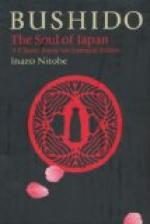“With the kaishaku on his left hand, Taki Zenzaburo advanced slowly towards the Japanese witnesses, and the two bowed before them, then drawing near to the foreigners they saluted us in the same way, perhaps even with more deference; in each case the salutation was ceremoniously returned. Slowly and with great dignity the condemned man mounted on to the raised floor, prostrated himself before the high altar twice, and seated[19] himself on the felt carpet with his back to the high altar, the kaishaku crouching on his left hand side. One of the three attendant officers then came forward, bearing a stand of the kind used in the temple for offerings, on which, wrapped in paper, lay the wakizashi, the short sword or dirk of the Japanese, nine inches and a half in length, with a point and an edge as sharp as a razor’s. This he handed, prostrating himself, to the condemned man, who received it reverently, raising it to his head with both hands, and placed it in front of himself.
[Footnote 19: Seated himself—that is, in the Japanese fashion, his knees and toes touching the ground and his body resting on his heels. In this position, which is one of respect, he remained until his death.]
“After another profound obeisance, Taki Zenzaburo, in a voice which betrayed just so much emotion and hesitation as might be expected from a man who is making a painful confession, but with no sign of either in his face or manner, spoke as follows:—
’I, and I alone, unwarrantably gave the order to fire on the foreigners at Kobe, and again as they tried to escape. For this crime I disembowel myself, and I beg you who are present to do me the honor of witnessing the act.’
“Bowing once more, the speaker allowed his upper garments to slip down to his girdle, and remained naked to the waist. Carefully, according to custom, he tucked his sleeves under his knees to prevent himself from falling backward; for a noble Japanese gentleman should die falling forwards. Deliberately, with a steady hand he took the dirk that lay before him; he looked at it wistfully, almost affectionately; for a moment he seemed to collect his thoughts for the last time, and then stabbing himself deeply below the waist in the left-hand side, he drew the dirk slowly across to his right side, and turning it in the wound, gave a slight cut upwards. During this sickeningly painful operation he never moved a muscle of his face. When he drew out the dirk, he leaned forward and stretched out his neck; an expression of pain for the first time crossed his face, but he uttered no sound. At that moment the kaishaku, who, still crouching by his side, had been keenly watching his every movement, sprang to his feet, poised his sword for a second in the air; there was a flash, a heavy, ugly thud, a crashing fall; with one blow the head had been severed from the body.
“A dead silence followed, broken only by the hideous noise of the blood throbbing out of the inert head before us, which but a moment before had been a brave and chivalrous man. It was horrible.




